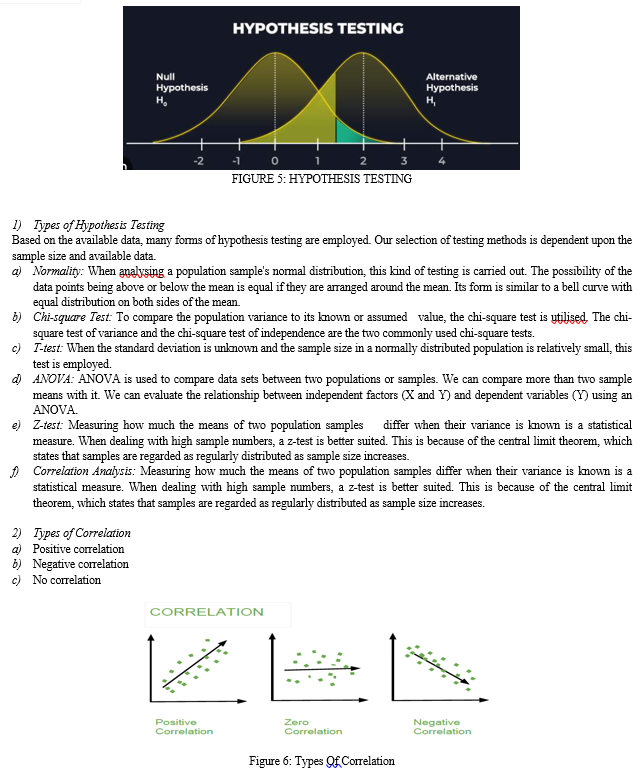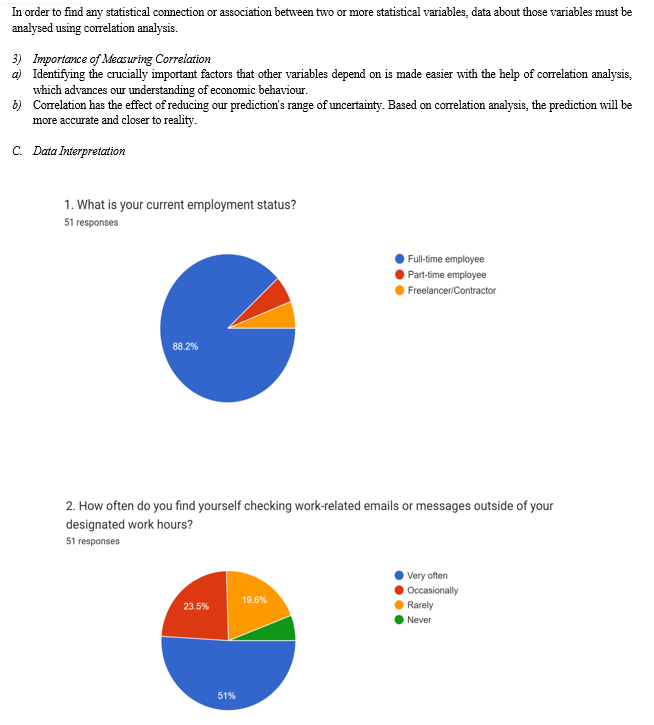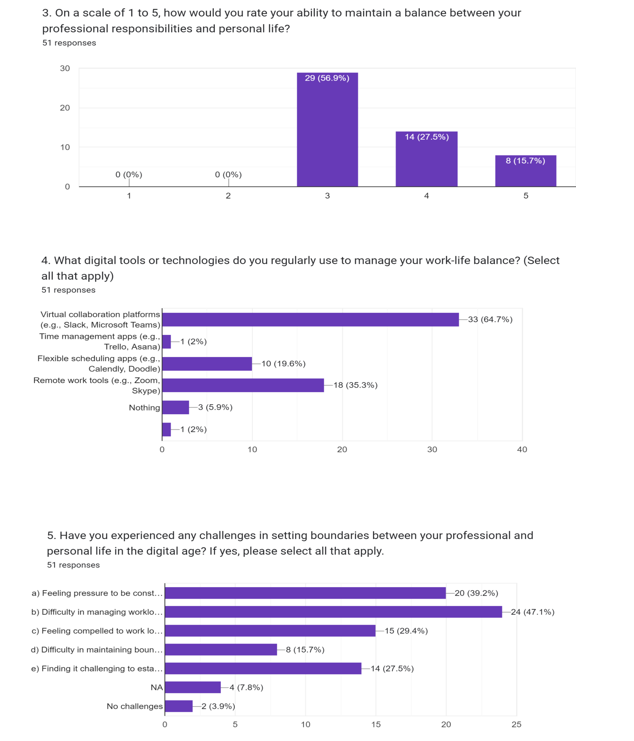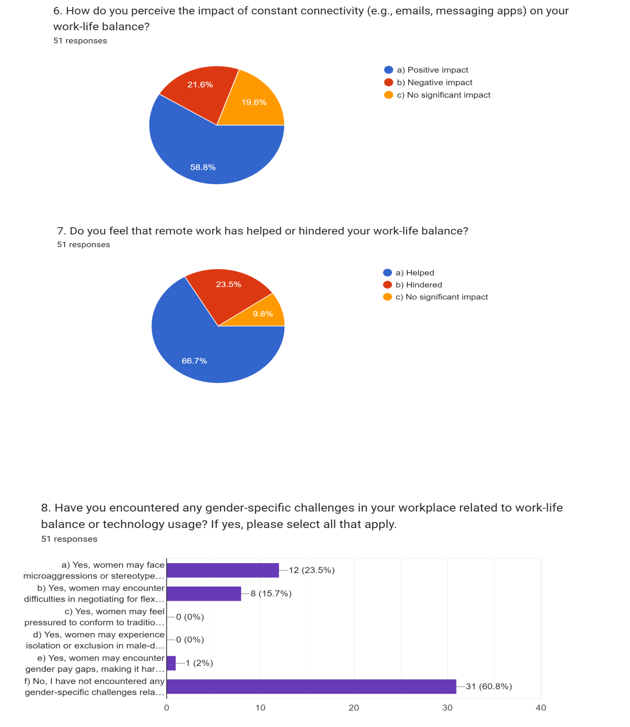Ijraset Journal For Research in Applied Science and Engineering Technology
- Home / Ijraset
- On This Page
- Abstract
- Introduction
- References
- Copyright
A Study on Work-Life Balance of Women in the Digital World
Authors: Pragathi N, Dr. Vinayak Anil Bhat
DOI Link: https://doi.org/10.22214/ijraset.2024.60288
Certificate: View Certificate
Abstract
This study explores the vast dynamics of women\'s work-life balance if they are employees in the digital world. The study looks into how well the female employees can balance between their professional responsibilities and personal lives. The study addresses the challenges that women face in the digital age, such as managing the boundaries between work and home life, the effects of constant connectivity, and the possible benefits and drawbacks of remote employment in terms of work-life balance. This study looks at how technology can help women manage their personal and professional responsibilities more effectively.The potential of digital solutions, such apps that allow for flexible scheduling and virtual collaboration platforms, to help women achieve a healthy balance between their home and professional lives are examined. The research also examines the significance of cultural changes in fostering an environment that is welcoming and all-encompassing for women navigating the challenges of the digital workplace. Lastly, the study sheds light on how women, the workplace, and technology interact in the digital era.
Introduction
I. INTRODUCTION AND REVIEW OF LITERATURE
A. Introduction
Women have faced particular challenges in balancing the responsibilities of their personal and professional lives. It is essential that women in the digital age receive support in understanding the significance of work-life balance. Setting boundaries, setting a high priority on self-care, and establishing a healthy boundary between work and personal life are all aided by it. It also helps the organisation with policy-making, employee communication, job satisfaction, and career growth. It is a never-ending and constant journey. Human resource management helps the process of planning and developing strategies. Our work-life balance is more flexible and open thanks to digitalisation. Due to innovations in mobile technology, cloud-based software, and the internet, working remotely and at any time is now possible. In the digital age, technology has transformed the way we work. The blurring of the lines between personal and professional activities as a result of technological improvements might make it more difficult to maintain a healthy work-life balance. When the balance between personal and work is disrupted, it can lead to burnout, stress and decreased productivity .If various employees have different perspectives, gender differences may result in an imbalance between work and life. Workplace sexism can take many different forms, varying from mild injustice to outright discrimination. Whichever kind it is, it may prevent people from realising their full potential, create a toxic work environment, and result in unfair treatment.It encourages us to learn about the difficulties of always being related thru technology, evaluate the benefits and drawbacks of working remotely, and to understand how women's perspectives are affected by technology.
It's possible that certain companies lack inclusive policies that adapt to the unique demands of women in the digital age. This can involve inadequate family leave or maternity policies, flexible work schedules, or support for women who want to be in leadership positions. The research provides insights on the coordination between women, work, and technology in the digital age.
Women's work-life balance is becoming an increasingly serious issue. Women deal with a variety of issues in the workplace. A few of them
- Work and family conflicts affect women.
- Women who work long hours and receive inadequate pay due to their excessive workload.
- Family leave and maternity policies, etc.
While an imbalance in work-life negatively impacts both private and professional lives, work-life balance enables women to effectively manage both their personal and professional lives. Encouraging a healthy work-life balance benefits both firms and employees. job-family conflicts arise when balancing the demands of job and family life becomes difficult. Utilising digital technologies improves interaction and cooperation amongst people, resulting in a better work-life balance and increased productivity. Reducing job-related stress and creating a welcoming, safe, and discrimination-free work environment are essential to female employees' work-life balance.
The advantages of technology, especially in terms of quicker workflows and the capacity for workers—including women—to work remotely. This fits quite nicely with the overarching idea of leveraging digital tools to enhance work-life balance.

???????B. The Rationale For The Study
The goal of this research is to examine how female employees manage their professional and personal lives. The primary impact is on finding a balance between responsibilities in one's personal and professional life. The work-life balance is influenced by a wide range of elements, including social and psychological aspects of the workplace, job type, work history, maternity leave, and more. The individual who can successfully achieve a balance between the two can make a greater contribution to the organisation's success. Technology has completely changed the way we operate in the digital age by providing more freedom and connectedness. Gender inequality still exists in many industries, especially in those that rely heavily on digital technologies. By examining women's work-life balance, we can better understand how to create inclusive digital workplaces where women are not disadvantaged by the change to digital technology. I will be able to better understand how women in the digital era manage their personal and professional lives by conducting research on the subject of women's work-life balance if they are employed. It will benefit me in my future career development as a student of HR. For this reason, I feel that conducting this research on this specific subject is crucial.
C. Challenges Of Work-Life Balance Of Women In The Digital Age
According to the report, women have trouble maintaining a balance between work and life mostly as a result of the daily obstacles they encounter at work. The difficulties that women encounter are:
- Pay disparities and sexual harassment
- Inequitable opportunities
- Discrimination based on pregnancy
- inflexible work schedule
- bias against women
- between obligations to your family and your work
Women in the digital era generally encounter the numerous difficulties mentioned above. They have a lot of pressure to perform well on the job and still take care of their families. Lack of flexible work schedules might lead to high levels of stress that will impact their personal and professional lives. The mental health of women may suffer as a result. Women frequently struggle to detach from work, which makes it difficult for them to balance their personal obligations.
One of the biggest obstacles to women's work-life balance is stress. Excessive stress can cause new issues and a poor work-life balance, and it can be challenging to address these issues if it is not treated or addressed right away.
D. Review Of Literature
Aggarwal (2012) examined how employee views toward work-life conflicts and the workplace as a whole related to work-life balance initiatives. According to the study, employees believe that having a work-life balance improves their productivity and that employers and employees should share responsibility for it.
According to Liyana and Norizan (2017) Women frequently carry the burden of childcare and other household duties. Cross & Linehan (2006) emphasise that as a result, working women are frequently categorised as having "multitasking" skills. "Multitasking" is one of the few skills that allows women to successfully juggle work and family obligations. However, these dual responsibilities frequently represent a significant barrier to their professional advancement.
The study by Francene Sussner Rodgers (1992) In a sample of workers from 20 Fortune 500 companies, 28% of men and 53% of women said that work-family stress hindered their ability to focus at work. This indicates that over half of women and nearly a third of men said that work-family stress interfered with their ability to focus at work. For working women, life at work looks to be very Challenging.
Sundaresan S. (2015) Everyone conducted a study on the consequences of work-life balance for working women among 125 women in Bangalore, India. The survey found that the main problems affecting working women's work-life balance are the burden of excessive work, the pressure to live up to others' expectations, and a lack of time for them. Women consequently endure high levels of stress and worry, burn out from their jobs, are unable to reach their full potential, and do not have happy, fulfilling families.
According to the article of Chandel, P & Shekhawat, J. (2019) on Body Image, Mental Health, and Quality of Life of Married Working Women in India found that long work hours, a lack of support from friends and family, and a severe workload are the main causes of mental stress among working women.According to the article, support and confidence from friends, family, and society can improve a married working woman's quality of life.
Soi and Massey (2011) researched the idea of work-life balance and how it affects employee productivity and employment relations. The study shed light on the disparity that today's fast-paced working age faces between work and life. Due to an imbalance that has developed between their job and personal lives, it was found that the majority of respondents weren't content with the shape that their lives had taken recently.
(Greenhaus et al., 2003) A person is said to be in a condition of work-life balance when they are content and attached to their roles as a worker and a family member.
(Bharat, 2003; Komarraju, 1997; Rajadhyaksha & Bhatnagar, 2000; Ramu, 1989; Sekharan, 1992) Due to the increasing number of dual-career families and the extended workweeks associated with high job expectations, work-life balance is becoming increasingly important in all fields of employment. It has been highlighted how crucial it is to assist staff members in striking a balance between the demands of their personal and professional lives. A more varied workforce and a higher need for workers to balance their professional and personal lives are the results of demographic shifts, as evidenced by the rise in the number of women in the workforce and dual-career families.
(Grossman, 1981) Women now have more access thanks to the knowledge economy and other variables like smaller families and changing marriage patterns. As a result, there are now more working mothers and working women overall.
(Sunita Malhotra & Sapna Sachdeva, 2005) Women have been provided with occupational opportunity and mobility in this era of knowledge. However, this gift has turned into a significant difficulty for today's professional women, who face pressures from competing expectations and varied role demands in addition to sharing the same workplace as males. "Work has undoubtedly helped women become independent and have a distinct social standing by meeting their basic requirements, but it has also forced them to balance their roles in the two most important areas of their lives: work and family. Even though more women are entering the workforce, their duties are still the same—that is, even while they may hold senior executive positions, "nurturing" or "caregiving" roles are still seen as much more important.
II. RESEARCH METHODOLOGY
???????A. Scope Of The Study
Developing and implementing mental shifts to help people achieve a balance between their personal and professional lives is known as work-life balance. The significance of work-life balance is covered in this study. It will also cover the difficulties and chances that women encounter in the workplace. The way we work has always been changed by digitalization. We have more flexibility to design our work-life balance, but it also creates boundaries between work and personal life. This study addresses the conflicting demands of work and family, examines various work-life balance strategies, explains how to put them into effect, and outlines what women may do to manage it. ensuring that there is no discrimination and that the workplace is safe.
The goal of this is to identify the factors influencing women's work-life balance. It indicates the degree to which women are capable of managing labour for the organisation, society as a whole, and themselves. This study determined the different steps that the company should take to enhance the work-life balance of its female employees and create an environment that inspires them and makes them feel happy. Increasing people's quality of life while increasing chances for advancement in careers and paid work are the goals of work-life balance.
???????B. Research Objectives
This study aims to investigate the association between women's work-life balance and demographic factors such as age, gender, marital status, religion, educational background, and monthly income.Additionally, it seeks to identify workplace obstacles such as sexual harassment, gender discrimination, and non-flexible work schedules. Making sure that women feel valued and protected at work is the goal of this research.
- Women are capable of managing their personal and professional lives when they achieve work-life balance.
- The goal of the research is to have a comprehensive understanding of women's work-life balance.
- To understand and deal with the issues that female employees have at work.
- To suggest ways to enhance women's work-life balance.
- Additionally, this research demonstrates how women successfully manage business and personal work at the same time.
- The issues that women encounter at work, such as sexual harassment, gender bias, unequal pay, lack of equal chances, and non-flexible work schedules, will also be covered in this study.
- determines the elements influencing the work-life balance of the staff.
- Women will be paid similarly to males thanks to this research as well.
- This study offers a survey.
The goal of the research will assist the HR department in planning and developing a strategy, improving benefits for female employees, creating an atmosphere free from discrimination, and ensuring that they have flexible work schedules. Additionally, this research will enable women to find balance in their personal and professional lives.
C. Framing Of Research Hypothesis
A research hypothesis is a prediction or anticipation that will be investigated through study. An argument that can be tested or disproved is called a hypothesis. In order to shed light on the elements that promote or hinder women's ability to attain a better work-life balance, the hypothesis attempts to investigate the correlations between various variables and women's work-life balance in the digital world. Since it is crucial, the research on the idea should be focused and clear.
The fact that the hypotheses follow the research questions is a further essential aspect. The research problem and the study purpose are made clearer by the hypothesis. A statement that suggests a relationship between two or more independent variables is called a hypothesis. An independent variable is something the researcher can control. A dependent variable is something that is being observed and measured.
Null Hypothesis - the assumption that there is no connection between the variables is called null hypothesis.
Alternative Hypothesis - The alternative hypothesis proposes that the association between the two variables is statistically significant.

D. Research Design
A study's research design is the framework for the methodologies and strategies that the researchers have decided to use. The design enables researchers to focus on the most effective research techniques for the topic at hand and organise their investigations for success. The study's design phase establishes the instruments to be utilised as well as their methods.
There are three main types of design of the research :
- Data collection
- Measurement
- Data analysis
Types of research design :
a. Descriptive
b. Diagnostic
c. Experimental
d. Correational
e. Explanatory

???????E. Methods For Data Collection And Variable Of Study
To answer research questions, test hypotheses, and analyse results, data collection is the systematic process of obtaining and quantifying information on variables of interest. One can determine the answer to the relevant question using the data collection approach. The data organisation procedure must be followed after the data has been gathered. The majority of organisations make assumptions about future possibilities using data collection techniques.
Primary and secondary data are the two categories into which data can be divided. Primary data is information that has never been utilised before and is observed or gathered directly from first-hand experience. Interviews and questionnaires are two examples. Data that has already been used is known as secondary data. Surveys, journals, publications, websites, magazines, etc. are a few examples.
Depending on the type of data, the data collection method is divided into two categories namely,
- Primary Data Collection Methods
Primary data is information that has never been utilised before and is observed or gathered directly from first-hand experience. Examples are questionnaires and interviews.
a. Questionnaires: It is a series of written or printed questions with multiple choice responses intended for use in survey research. A questionnaire is a set of questions intended to collect information from survey respondents' answers. Data can be gathered using questionnaires in both quantitative and qualitative ways.
b. Interview: An organised communication in which one party asks questions and the other responds is called an interview. It describes an interview that takes place one-on-one between the interviewee and the interviewer. They are different types of interview that are:
a. Structured interview
b. Unstructured interview
c. Behavioural interview
d. Situational interview
e. Interviews over the phone or via video
f. Technical interviews
g. individual interviews
2. Secondary Data Collection Method
Data that has already been used is known as secondary data. Put in various ways, it refers to information that has already been gathered from primary sources and is easily accessible for researchers to utilise in their own studies. Secondary data is quite beneficial. Secondary data contains
a. Journals
b. Magazines
c. Company websites
d. Textbooks
e. Surveys
Variables of study
Variables aims to provide an in-depth understanding of the elements influencing women's ability to properly combine work and personal life duties by gathering many facets of their experiences with work-life balance in the digital era.
III. DATA ANALYSIS AND INTERPRETATION
Define why you need the data analysis:
Understanding the aim of the data analysis is the first stage in the process. This stage aids in understanding the goal of the analysis and the rationale behind its necessity.
- Collect Data from Sources
The next step in the data analysis process is to determine its goal and begin gathering data from all relevant sources, including primary and secondary sources.
2. Cleaning the Unnecessary Data
- During this stage of the procedure, all data that is not needed for the analysis is removed. In the course of cleansing the data, you will probably be:
- Removing significant mistakes, repetitions, and outliers
- Eliminating unnecessary data points
- Organising the information
- Correcting significant data gaps
3. Analysing the Data
The next stage is to start analysing the data from the acquired data after removing any unnecessary details from the data analysis process.
4. Sharing the Results and Applying Them
This last stage of the data analysis procedure applies and interprets the findings.

A. Techniques For Data Analysis
The process of analysing data to find meaningful information is known as data analysis. Statistical and analytical tools are used to clean, transform, inspect, and analyse the data in order to do this. Effective data analysis aids organisations in making better business choices. These days, social media, newsletters, polls, and other methods are used to gather data. The many methods for analysing the data include:
- Regression Analysis: The connection between one dependent variable and one or more independent variables is investigated using regression analysis. Based on the value of the independent variable, it helps in forecasting the value of the dependent variable. Regression analysis gives you the confidence to identify the most important components, the factors that may be disregarded, and the relationships between these factors.
- Time series Analysis: Data collected throughout time is analysed using time series analysis. Determining the type of event represented by the series of observations and forecasts is the aim. It gives people a view into the future, which is incredibly helpful. Analysing time series data can assist in understanding the true significance of the data.
- Descriptive Analysis: A type of data study known as descriptive analysis helps to describe, illustrate, or summarise data points so that those patterns can emerge and meet all of the data's requirements. Variables like mean, median, mode, standard deviation, range, and frequency distributions are included in this.
- Trend Analysis: The process for evaluating and forecasting an item's movements based on recent and past data is called trend analysis. The popular method of gathering data and looking for patterns is known as trend analysis. Three key elements of trend analysis are innovation, external change, and basic needs.
B. Hypothesis Testing And Methods
Testing a hypothesis involves looking at a population parameter assumption. It is employed to use statistics to infer an appropriate conclusion about an assumption. Hypothesis testing establishes assumptions about how valid the assumptions are for the entire population from which the sample is being drawn using a sample of data.
It is our duty to present evidence for the plausibility of any hypothesis statements we make, regardless of its validity. We approach every hypothesis by using these four easy steps to determine whether it is valid
- First, we create two hypothetical claims, of which only one can be true. We can verify the accuracy of our hypothesis by doing this.
- The next stage is to use the data points to formulate the statistical analysis that will be performed.
- Next, we apply our algorithms to analyse the provided data.
- Analysing the outcome and determining whether it will be accepted or rejected is the last stage.





The above analysis shows how women manage both work and their personal life and after an overall analysis it shows how women are adapting to the digital era. When asked their current employment status , out of 51 responses 88.2% of the women have chosen full time. When asked how often they find themselves checking work-related emails or messages outside of your designated work hours, out of 51 responses 51% have chosen very often. When asked on a scale of 1 to 5, how would they rate their ability to maintain a balance between their professional responsibilities and personal life 56.9% out of the 51 responders had chosen 3 on the scale . When asked what digital tools or technologies they regularly use to manage your work-life balance 64.7% of them from the 51 responders have chosen virtual collaboration platforms. When asked have you experienced any challenges in setting boundaries between your professional and personal life in the digital age 47.1% from the 51 responders have chosen difficulty in managing workload expectations due to digital communication. When asked how they perceive the impact of constant connectivity (e.g., emails, messaging apps) on their work-life balance 58.8% from the 51 responders have chosen positive impact. When asked if they feel that remote work has helped or hindered their work-life balance, 66.7% from the 51 responders have chosen that it has helped them. When asked if they encountered any gender-specific challenges in your workplace related to work-life balance or technology usage 60.8% from the 51 responders have chosen No, they haven't encountered any gender-specific challenges related to work-life balance or technology usage in their workplace. When asked how satisfied are they with the existing work-life balance policies and support provided by your organisation 43.1 % from the 51 responders have chosen neutral ( average) When asked what cultural shifts or organisational changes could better support women in achieving work-life balance in the digital age 58.8% from the 51 responders have chosen to provide access to technology training and resources to enhance digital skills and also they want to establish clear communication channels for setting boundaries between work and personal life.
IV. FINDINGS AND RECOMMENDATIONS
A. Research Outcome And Findings
The majority of the women who participated in the survey are full-time employees, according to the research's findings. Additionally, our research showed that they frequently check their phones—even after work. This shows how difficult it is to keep boundaries between one's personal and professional lives. Digital tools that are used most often to manage work-life balance are virtual collaboration platforms. This shows how technology has made it possible to have flexible work schedules. It also shows how challenging it is for them to manage the demands of their workload brought on by digital communication. In the digital age, this problem is frequently encountered. For the most part, they believe that working remotely has improved their work-life balance. Very few of them have faced challenges specific to their gender. It also highlights how crucial it is to give people access to technology training, help them develop their digital abilities, and establish clear lines of communication to help them draw boundaries between their personal and professional lives.
Balance between work and life is crucial for women. The majority of employees believe that they ought to be provided a flexible schedule. They may better balance their personal and professional lives as a result. Additionally, it will make the work more efficient. They will be able to assign equal weight to work and home as a result, and they will also realise that those who are able to achieve this balance experience less stress and are more productive.
The results also shed light on how women in the digital age must manage work-life balance. The recommendations for implementing organisational and cultural reforms as well as forging a friendly workplace culture.
B. Recommendations
The purpose of this research was to investigate how women's work lives in the digital age are impacted. The following changes and recommendations under this study should be made:
Conduct campaigns to inform staff members—particularly women—about the value of preserving a positive work-life balance.
- Allowing for flexible work schedules to assist staff in balancing their personal and work responsibilities.
- Create training and development programs aimed at enhancing workers' digital skills.
- Offering learning opportunities to guarantee that staff members have the confidence to use digital tools efficiently.
- Putting techniques into practice to assist staff in managing their workload by establishing precise guidelines for when emails and messages sent outside of business hours will be answered.
- Provide a comfortable atmosphere at work where staff members may confide in one another and ask for help when they need it from mentors or other staff members.
- putting into practice programs aimed at advancing gender equality.
- Establish open lines of contact with the company to establish boundaries between your personal and professional lives.
- Make sure staff members are free to disconnect as needed without worrying about the consequences.
- Promote procedures like flexible scheduling.
- Motivate supervisors to take the lead by exemplifying positive work-life balance techniques..
C. Conclusion
In conclusion, women's working lives have fundamentally transformed as a result of the digital era, which presents both opportunities and challenges for those seeking a healthy work-life balance. Many women think that maintaining continual communication improves their ability to better balance their personal and professional lives. Despite all the challenges, women believe that working remotely has enabled them to maintain a healthy work-life balance. In the digital age, having supporting organisational policies is essential to having a balanced work-life. Organisations should enable women to lead better personal lives along with succeeding professionally. It is essential that we give women's success and well-being in the workplace top priority.
Organisations that respect each employee's right to a work-life balance and have a clear knowledge of their business case are more likely to have successful work-life balance policies.
References
[1] https://www.researchgate.net/publication/372139370_A_STUDY_ON_PROBLEMS_RELATED_TO_WORK_LIFE_BALANCE_AMONG_WOMEN_EMPLOYEES_IN_IT_SECTOR_WITH_REFERENCE_TO_CHENNAI [2] https://continentalhospitals.com/blog/balancing-work-and-life-in-the-digital-era/ [3] https://images.app.goo.gl/tWKKL5JxckNW9aXi6 women work life balance [4] https://www.financialexpress.com/lifestyle/work-life-balance-is-a-continued-challenge-for-women-employees-and-how-to-deal-with-this-stress/2706841/ [5] https://saudijournals.com/media/articles/SJBMS_75_125-132.pdf [6] https://www.researchgate.net/publication/312385528_WORK_LIFE_BALANCE_OF_FEMALES_EMPLOYEES_A_CASE_STUDY [7] https://www.academia.edu/61176259/Work_Life_Balance_of_Women_Employees_in_the_Information_Technology_Industry [8] https://www.questionpro.com/blog/research-design/ [9] https://www.simplilearn.com/what-is-data-collection-article [10] https://images.app.goo.gl/otPhG2TvVbT2FwJs6 the data analysis process [11] https://images.app.goo.gl/q31wLJ3W8h8pqts1A importance of hypothesis [12] https://www.springboard.com/blog/data-analytics/data-analysis-process/ [13] https://images.app.goo.gl/FCZu89snTJR9qpNm6 types of research design [14] https://careerfoundry.com/en/blog/data-analytics/the-data-analysis-process-step-by-step/ [15] https://www.analyticssteps.com/blogs/what-hypothesis-testing-types-and-methods hypothesis testing [16] https://www.scirp.org/journal/paperinformation.aspx?paperid=74810 [17] https://images.app.goo.gl/baXwozBnFF6iCNTL8 types of correlation [18] https://www.researchgate.net/profile/Dr-Saloni-Pahuja/publication/312385528_WORK_LIFE_BALANCE_OF_FEMALES_EMPLOYEES_A_CASE_STUDY/links/592da18745851553b64ae68c/WORK-LIFE-BALANCE-OF-FEMALES-EMPLOYEES-A-CASE-STUDY.pdf [19] https://www.academia.edu/download/97540179/tinaporwal_2C_07_IJETMR20_A02_2021.pdf_filename_UTF-8tinaporwal_2C_07_IJETMR20_A02_2021.pdf [20] https://www.academia.edu/44713859/WORK_LIFE_BALANCE_ISSUES_FACED_BY_WORKING_WOMEN?uc-g-sw=47578485 [21] https://www.academia.edu/96573688/Issues_of_working_women_in_work_life_ballance?rhid=27177463428&swp=rr-rw-wc-44713859&nav_from=f94a5708-53ac-4d7a-9dcd-472208c7d3db&rw_pos=14 [22] https://www.academia.edu/36911520/WORK_LIFE_BALANCE_STUDY_FOCUSED_ON_WORKING_WOMEN?rhid=27177821550&swp=rr-rw-wc-35607320&nav_from=8557d4fc-a079-4914-b1c8-a0b53832e5c3&rw_pos=1 [23] https://www.academia.edu/44302239/Work_Life_Balance_of_Working_women_An_overview?rhid=27177821550&swp=rr-rw-wc-35607320&nav_from=2b3e14c8-19ba-4382-a85d-a2618bd1ae31&rw_pos=7 [24] https://www.researchgate.net/profile/Balaji-Rangarajan/publication/321126509_Work_Life_Balance_of_Women_Employees/links/5a0e92c545851541b707b2ac/Work-Life-Balance-of-Women-Employees.pdf [25] https://www.academia.edu/36911520/WORK_LIFE_BALANCE_STUDY_FOCUSED_ON_WORKING_WOMEN?rhid=27205244823&swp=rr-rw-wc-44302239&nav_from=fce17aab-261f-41ed-b021-72934f9076b0&rw_pos=3
Copyright
Copyright © 2024 Pragathi N, Dr. Vinayak Anil Bhat. This is an open access article distributed under the Creative Commons Attribution License, which permits unrestricted use, distribution, and reproduction in any medium, provided the original work is properly cited.

Download Paper
Paper Id : IJRASET60288
Publish Date : 2024-04-14
ISSN : 2321-9653
Publisher Name : IJRASET
DOI Link : Click Here
 Submit Paper Online
Submit Paper Online

